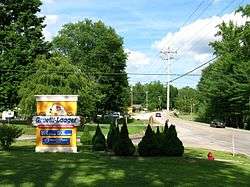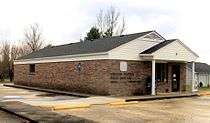Gruetli-Laager, Tennessee
Gruetli-Laager is a city in Grundy County, Tennessee, United States. The population was 1,813 at the 2010 census.[6] As its name implies, Gruetli-Laager consists of two communities— Gruetli and Laager— incorporated as a single city.
Gruetli-Laager, Tennessee | |
|---|---|
 SR 108 in Gruetli-Laager | |
 Location of Gruetli-Laager in Grundy County, Tennessee. | |
 Gruetli-Laager Location of Gruetli-Laager in Grundy County, Tennessee.  Gruetli-Laager Gruetli-Laager (the United States) | |
| Coordinates: 35°22′23″N 85°37′25″W | |
| Country | United States |
| State | Tennessee |
| County | Grundy |
| Settled | 1869 |
| Incorporated | 1980[1] |
| Area | |
| • Total | 12.68 sq mi (32.83 km2) |
| • Land | 12.68 sq mi (32.83 km2) |
| • Water | 0.00 sq mi (0.00 km2) |
| Elevation | 1,916 ft (584 m) |
| Population (2010) | |
| • Total | 1,813 |
| • Estimate (2019)[3] | 1,738 |
| • Density | 137.11/sq mi (52.94/km2) |
| Time zone | UTC-6 (Central (CST)) |
| • Summer (DST) | UTC-5 (CDT) |
| ZIP code | 37339 |
| Area code(s) | 931 |
| FIPS code | 47-31490[4] |
| GNIS feature ID | 1648587[5] |
History
Gruetli was founded by German-speaking Swiss immigrants in 1869. The town was part of a greater initiative— conducted by an organization known as the Tennessee Kolonisation Gesellschaft— to establish Swiss colonies atop the Cumberland Plateau in Tennessee.[7] Gruetli was probably named after a commune in the Swiss canton of Glarus.[8] Peter Staub, a member of Knoxville's thriving Swiss community, helped purchase the initial tract of land for Gruetli. The land was advertised in Switzerland, where the opportunity for a new start appealed to many families struggling with difficult economic conditions in Europe.[7]

Although over 100 Swiss families moved to the Gruetli area in the 1870s, many were disappointed by the land's poor quality and relative isolation, and thus relocated to nearby cities. Nevertheless, by 1880, Grundy County had the largest Swiss population of any county in Tennessee. Prominent early settlers at Gruetli included Christian Marugg, who operated an inn along the stagecoach road between Chattanooga and McMinnville, and Melchior Thoni, Jr. (1849–1926), a woodcarver whose work was displayed in the old Governor's Mansion and the Christ Church in Nashville.[7][9]
Throughout the early 1900s, railroads were constructed in the hills east of Gruetli to accommodate various coal mining operations in the area. Laager was established as a railroad stopover (initially known as "Henley's Switch") in 1918. Gruetli and Laager merged and incorporated in 1980.[7][10]
Geography
Gruetli-Laager is located southeast of the center of Grundy County at 35°22′23″N 85°37′25″W (35.373152, -85.623617).[11] The city is situated atop the southern Cumberland Plateau, roughly halfway between the plateau's Sequatchie Valley escarpment to the east and its Highland Rim escarpment to the west. Just north of the city, the Collins River and its upper watershed slice a gorge known as "Savage Gulf" as the river descends the plateau en route to its confluence with the Caney Fork at Rock Island.
Gruetli-Laager stretches for several miles along Tennessee State Route 108 (SR 108). The highway connects the area with the Sequatchie Valley and Chattanooga area to the southeast. Just west of Gruetli-Laager, SR 108 intersects SR 56, which connects the area to Monteagle and Interstate 24 to the southwest and McMinnville to the northwest.
According to the United States Census Bureau, the city has a total area of 12.5 square miles (32.5 km2), all land.[6]
Demographics
| Historical population | |||
|---|---|---|---|
| Census | Pop. | %± | |
| 1990 | 1,810 | — | |
| 2000 | 1,867 | 3.1% | |
| 2010 | 1,813 | −2.9% | |
| Est. 2019 | 1,738 | [3] | −4.1% |
| Sources:[12][13] | |||
As of the census[4] of 2000, there were 1,867 people, 720 households, and 540 families residing in the city. The population density was 150.0 people per square mile (57.9/km2). There were 765 housing units at an average density of 61.4 per square mile (23.7/km2). The racial makeup of the city was 99.25% White, 0.05% Asian, 0.05% from other races, and 0.64% from two or more races. Hispanic or Latino of any race were 0.54% of the population.

There were 720 households, out of which 34.6% had children under the age of 18 living with them, 59.2% were married couples living together, 11.9% had a female householder with no husband present, and 25.0% were non-families. 22.9% of all households were made up of individuals, and 11.7% had someone living alone who was 65 years of age or older. The average household size was 2.59 and the average family size was 3.03.
In the city, the population was spread out, with 27.3% under the age of 18, 9.6% from 18 to 24, 28.0% from 25 to 44, 22.4% from 45 to 64, and 12.6% who were 65 years of age or older. The median age was 35 years. For every 100 females, there were 93.3 males. For every 100 females age 18 and over, there were 92.5 males.
The median income for a household in the city was $23,101, and the median income for a family was $27,542. Males had a median income of $26,198 versus $17,634 for females. The per capita income for the city was $11,704. About 21.3% of families and 24.8% of the population were below the poverty line, including 35.5% of those under age 18 and 8.8% of those age 65 or over.
References
- Tennessee Blue Book, 2005-2006, pp. 618-625.
- "2019 U.S. Gazetteer Files". United States Census Bureau. Retrieved July 30, 2020.
- "Population and Housing Unit Estimates". United States Census Bureau. May 24, 2020. Retrieved May 27, 2020.
- "U.S. Census website". United States Census Bureau. Retrieved 2008-01-31.
- "US Board on Geographic Names". United States Geological Survey. 2007-10-25. Retrieved 2008-01-31.
- "Geographic Identifiers: 2010 Demographic Profile Data (G001): Gruetli-Laager city, Tennessee". American Factfinder. U.S. Census Bureau. Retrieved February 23, 2017.
- Claudette Stager, "Gruetli." The Tennessee Encyclopedia of History and Culture, 2009. Retrieved 9 February 2013.
- Tennessee Historical Commission marker 2E 43 on State Route 108. Information obtained 30 November 2008.
- Tennessee Historical Commission marker 2E 71 on TN-108. Information obtained 30 November 2008.
- William Ray Turner, "Grundy County." The Tennessee Encyclopedia of History and Culture, 2009. Retrieved 9 February 2013.
- "US Gazetteer files: 2010, 2000, and 1990". United States Census Bureau. 2011-02-12. Retrieved 2011-04-23.
- "Census of Population and Housing: Decennial Censuses". United States Census Bureau. Retrieved 2012-03-04.
- "Incorporated Places and Minor Civil Divisions Datasets: Subcounty Resident Population Estimates: April 1, 2010 to July 1, 2012". Population Estimates. U.S. Census Bureau. Archived from the original on 11 June 2013. Retrieved 11 December 2013.
External links
| Wikimedia Commons has media related to Gruetli-Laager, Tennessee. |
- Grundy County Swiss Historical Society — headquartered in Gruetli-Laager
- The Swiss Colony at Gruetli-Laager — article by Frances Helen Jackson